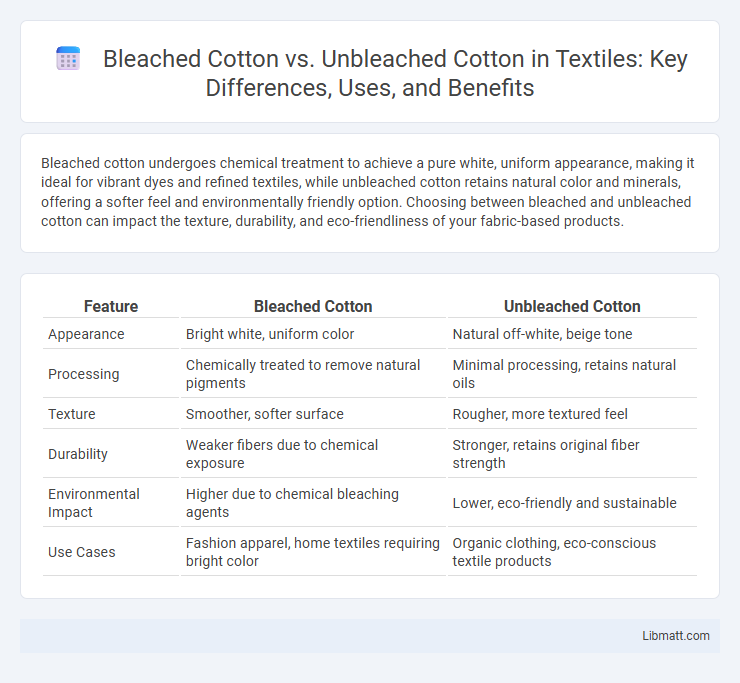Bleached cotton undergoes chemical treatment to achieve a pure white, uniform appearance, making it ideal for vibrant dyes and refined textiles, while unbleached cotton retains natural color and minerals, offering a softer feel and environmentally friendly option. Choosing between bleached and unbleached cotton can impact the texture, durability, and eco-friendliness of your fabric-based products.
Table of Comparison
| Feature | Bleached Cotton | Unbleached Cotton |
|---|---|---|
| Appearance | Bright white, uniform color | Natural off-white, beige tone |
| Processing | Chemically treated to remove natural pigments | Minimal processing, retains natural oils |
| Texture | Smoother, softer surface | Rougher, more textured feel |
| Durability | Weaker fibers due to chemical exposure | Stronger, retains original fiber strength |
| Environmental Impact | Higher due to chemical bleaching agents | Lower, eco-friendly and sustainable |
| Use Cases | Fashion apparel, home textiles requiring bright color | Organic clothing, eco-conscious textile products |
Introduction to Bleached and Unbleached Cotton
Bleached cotton undergoes a chemical process to remove natural pigments, resulting in a brighter, whiter fabric that is often preferred for its clean and uniform appearance. Unbleached cotton retains its natural color and texture, preserving more of the fiber's original strength and environmental benefits due to less chemical processing. Your choice between bleached and unbleached cotton impacts fabric durability, environmental sustainability, and aesthetic appeal depending on your specific needs.
What is Bleached Cotton?
Bleached cotton is cotton fabric that has undergone a chemical process to remove its natural color, resulting in a pure white appearance. This treatment enhances the fabric's brightness and makes it ideal for dyeing or printing vibrant colors. You can choose bleached cotton when you require a clean, uniform base for textiles or products that need a crisp, polished look.
What is Unbleached Cotton?
Unbleached cotton refers to cotton fibers that have not undergone the chemical bleaching process, retaining their natural off-white or cream color and preserving more of the cotton's original nutrients and softness. This type of cotton is less processed, making it environmentally friendlier due to fewer chemical treatments and reduced water pollution. Often favored for eco-friendly textiles and organic products, unbleached cotton offers durability and a more natural aesthetic compared to bleached cotton.
Production Processes: Bleached vs Unbleached Cotton
Bleached cotton undergoes a chemical treatment process involving chlorine or hydrogen peroxide to remove natural pigments, resulting in a pure white fabric ideal for dyeing and printing. Unbleached cotton retains its natural color and oils, bypassing harsh chemicals and preserving more of the fiber's inherent strength and softness. Your choice between bleached and unbleached cotton impacts environmental sustainability and fabric durability due to these distinct production processes.
Environmental Impact Compared
Bleached cotton undergoes chemical treatments that release toxins and consume significant water and energy, increasing pollution and carbon footprint. Unbleached cotton preserves natural fibers without harsh chemicals, reducing water contamination and energy use, making it a more eco-friendly choice. Choosing unbleached cotton can minimize environmental harm and support sustainable textile production.
Health and Safety Considerations
Bleached cotton undergoes chemical treatments that may leave residues potentially irritating sensitive skin or causing allergies, while unbleached cotton retains its natural fibers with minimal processing, reducing the risk of harmful exposure. Your health can benefit from choosing unbleached cotton products, which are less likely to contain synthetic chemicals or bleaching agents. Both materials require proper washing, but unbleached cotton is often considered safer for individuals with skin sensitivities or respiratory concerns.
Durability and Performance Differences
Bleached cotton undergoes chemical treatment to remove natural pigments, resulting in a softer texture but reduced fiber strength compared to unbleached cotton. Unbleached cotton retains its natural lignin and waxes, which contribute to greater durability and resistance to wear over time. Performance-wise, unbleached cotton fabrics typically offer enhanced longevity in heavy-use applications, while bleached cotton excels in aesthetic appeal and smoothness.
Applications and Common Uses
Bleached cotton is widely used in the production of white or light-colored textiles, including bed linens, towels, and medical fabrics due to its clean and uniform appearance. Unbleached cotton retains natural oils and fibers, making it a popular choice for eco-friendly products like reusable bags, organic clothing, and artisanal crafts where a more natural look is preferred. You can select bleached cotton for bright, refined finishes, while unbleached cotton suits applications prioritizing sustainability and texture.
Aesthetic and Texture Contrasts
Bleached cotton offers a crisp, bright white appearance with a smooth, uniform texture, making it ideal for clean, modern designs. Unbleached cotton retains its natural off-white or beige hue, accompanied by a slightly coarser, more organic texture that appeals to rustic or eco-friendly aesthetics. Your choice between bleached and unbleached cotton will significantly impact the fabric's visual appeal and tactile experience, aligning with your design preferences.
Choosing Between Bleached and Unbleached Cotton
Choosing between bleached and unbleached cotton depends on your preference for fabric texture and environmental impact. Bleached cotton undergoes chemical treatment to achieve a bright white finish, making it ideal for vibrant dyeing and smooth textures, whereas unbleached cotton retains its natural beige tone and is often favored for organic and eco-friendly products. Your choice should consider factors like skin sensitivity, sustainability, and the desired aesthetic for your textile projects.
Bleached cotton vs Unbleached cotton Infographic

 libmatt.com
libmatt.com